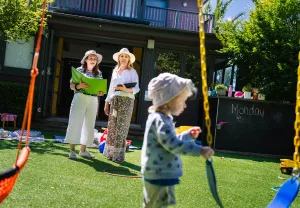Unpacking critical reflection in Standard 1.3
- Home
- Latest news
- We hear you
- Unpacking critical reflection in Standard 1.3

The NQF Snapshot Q2 2024 identifies Standard 1.3: Assessment and planning as the standard most often rated Working Towards NQS. Element 1.3.2: Critical reflection was identified as the second most often not met element across all service types. Therefore, we wish to offer some additional guidance to help service leaders and educators better understand the intent of this element and how it may look in practice.
Element 1.3.2 is specifically linked to the critical reflection of children’s learning and development within the educational program. The Guide to the National Quality Framework (NQF) outlines some of the ways educators might demonstrate critical reflection on children's learning and development for Element 1.3.2. This may include educators:
- considering how and why information is collected and analysing this to guide programming and planning
- questioning their decision making processes, including how they felt and why
- challenging their curiosities and potential bias
- considering theoretical perspectives that link to or underpin pedagogy
- utilising the approved learning frameworks to support critical reflection
- questioning how practices value diversity and promote inclusion for all children.
Understanding critical reflection will also support service leaders and educators to differentiate between Element 1.3.2: Critical reflection at a Meeting NQS level and Exceeding NQS Theme 2: Practice is informed by critical reflection.
When considering Exceeding NQS Theme 2 in relation to Standard 1.3, service leaders and educators must be able to demonstrate that they have critically reflected on the overall intent of the Standard. This reflection must also have informed the service’s holistic approach to assessment and planning. Service leaders and educators may consider reflecting on:
- what informs the service’s approach to assessment and planning
- which platforms, methods or formats they use for planning and documentation, and why
- whether the cycle of assessment and planning meets the needs of children, educators and families
- how information on children’s learning, development and wellbeing and the educational program is communicated to families
- how children’s and families’ voices can be heard and supported within the service’s approach to assessment and planning
- how the service could address potential barriers for educators and families to access and understand documentation of children’s learning.
Example: How Element 1.3.1 may evidence Exceeding NQS Theme 2
The following is an example of practice and reflection that aligns with Exceeding NQS Theme 2:
Educators expressed to service leaders that they found the planning and assessment cycle difficult to understand and document. The educational leader researched Gardner’s theory of multiple intelligences for discussion with the educators. They also surveyed the educators on their current understanding of the process and what could be improved.
After researching online programming platforms and paper based templates, educators debated the pros and cons of each method. They also discussed how this related to the multiple intelligence theory. The educators agreed on a 3 month trial period of a paper based visual mind map, which included symbols of the 8 Aboriginal Ways of Learning pedagogy framework.
After the trial, educators explained that the mind map process helped them to reflect on each stage of the assessment and planning cycle. It also prompted educators to explore early childhood research and draw on theories that inform plans for children's future learning.
The educators agreed that this method should be included in the staff meeting agenda to ensure it continues to meet the needs of educators and families. The educational leader created a document that explained the new process and added it to the educator induction pack and orientation process. The document was also adapted for families to explain the service planning cycle and share how families can contribute.
The Exceeding NQS guidance for Standard 1.3 should also be referred to when analysing whether a service practice supports the intent of the Standard at an Exceeding NQS level. Services should consider their own context when implementing practices, along with any relevant legislation.